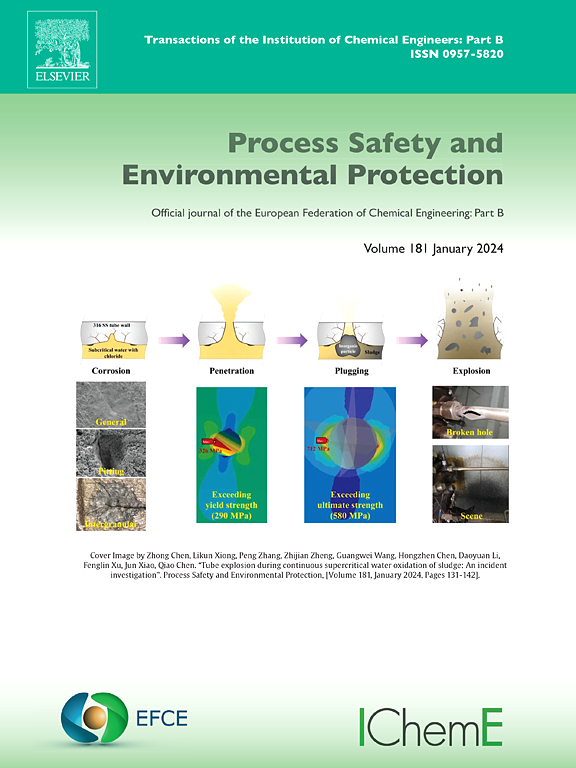石墨/MnOx单层电极与钛/MnOx单层电极在实际含盐废水电化学氧化处理中的比较
IF 7.8
2区 环境科学与生态学
Q1 ENGINEERING, CHEMICAL
引用次数: 0
摘要
在本研究中,采用电沉积法在钛和石墨衬底上制备MnOx电极,用于实际含盐废水的电氧化处理系统。两种衬底处理体系的电化学效率比较表明,最佳制备条件为电流密度:2.5 mA/cm2,时间:1和5 min,温度:50和35℃,溶液浓度:0.1和0.05 M,在500和300℃下煅烧1 h,在钛和石墨衬底下分别形成Mn2O3和α-MnO2的晶体结构。结果表明,该工艺对钛基板的去除率为8210µF/cm2,去除率为70% %;对石墨基板的去除率为84000µF/cm2,去除率为98.2% %。钛基板的制造过程能耗大于石墨基板(7 × 10−3 >;2.78 × 10−3 kWh),石墨基板处理采出水能耗大于钛基板处理(7.7 × 10−3 >;0.32 × 10−3 kWh/mg COD去除率)。结果表明,钛基具有较高的抗化学和物理降解能力,石墨基具有较高的抗电化学降解能力。本研究还展示了机器学习的集成,特别是人工神经网络(ANN),用于过程优化。该人工神经网络模型准确地识别出电极制作的最佳参数。为了获得最大的电化学容量,这些结果表明,所提出的MnOx电极在电氧化法处理实际含盐采出水和电化学储能方面非常有效。本文章由计算机程序翻译,如有差异,请以英文原文为准。
Comparison of single layer Graphite/MnOx and Ti/MnOx electrodes: Using in electrochemical oxidation treatment of real saline wastewater
In this study, the electrodeposition method was used to fabricate MnOx electrode on titanium and graphite substrates for use in real saline wastewater treatment systems by the electro-oxidation. Comparison of electrochemical efficiency in treatment systems between these two substrates showed that the best fabricating conditions are current density: 2.5 mA/cm2, time: 1 and 5 min, temperature: 50 and 35 °C, solution concentration: 0.1 and 0.05 M and calcination at a temperature of 500 and 300 °C for 1 h, which leads to the formation of a crystal structure of Mn2O3 and α-MnO2 in the case of using titanium and graphite substrate, respectively. The results showed the capacity of 8210 µF/cm2 and 70 % Chemical Oxygen Demand (COD) removal after 2 min for titanium substrate and 84,000 µF/cm2 and 98.2 % COD removal after 70 min for graphite substrate. The energy consumption in the fabricating process on the titanium substrate is more than that of graphite (7 × 10−3 > 2.78 × 10−3 kWh) and the energy consumption of produced water treatment with graphite substrate is more than that of titanium (7.7 × 10−3 > 0.32 × 10−3 kWh/mg COD removal). The results showed that titanium substrate has high resistance against chemical and physical degradation, while graphite showed high resistance against electrochemical degradation. This study also demonstrates the integration of machine learning, specifically Artificial Neural Network (ANN), for process optimization. The ANN model accurately identified optimal parameters for electrode fabrication. To achieve maximum electrochemical capacity, these results show that the proposed MnOx electrode is very efficient in treating real saline produced water by electro-oxidation method and also in electrochemical energy storage.
求助全文
通过发布文献求助,成功后即可免费获取论文全文。
去求助
来源期刊

Process Safety and Environmental Protection
环境科学-工程:化工
CiteScore
11.40
自引率
15.40%
发文量
929
审稿时长
8.0 months
期刊介绍:
The Process Safety and Environmental Protection (PSEP) journal is a leading international publication that focuses on the publication of high-quality, original research papers in the field of engineering, specifically those related to the safety of industrial processes and environmental protection. The journal encourages submissions that present new developments in safety and environmental aspects, particularly those that show how research findings can be applied in process engineering design and practice.
PSEP is particularly interested in research that brings fresh perspectives to established engineering principles, identifies unsolved problems, or suggests directions for future research. The journal also values contributions that push the boundaries of traditional engineering and welcomes multidisciplinary papers.
PSEP's articles are abstracted and indexed by a range of databases and services, which helps to ensure that the journal's research is accessible and recognized in the academic and professional communities. These databases include ANTE, Chemical Abstracts, Chemical Hazards in Industry, Current Contents, Elsevier Engineering Information database, Pascal Francis, Web of Science, Scopus, Engineering Information Database EnCompass LIT (Elsevier), and INSPEC. This wide coverage facilitates the dissemination of the journal's content to a global audience interested in process safety and environmental engineering.
 求助内容:
求助内容: 应助结果提醒方式:
应助结果提醒方式:


